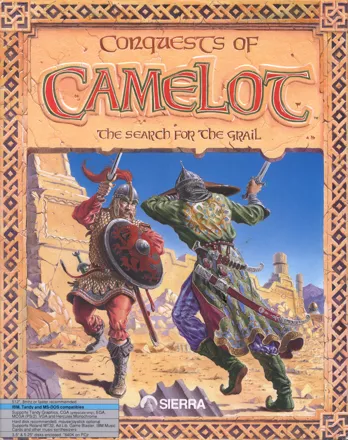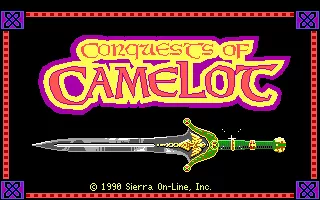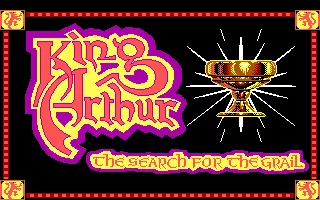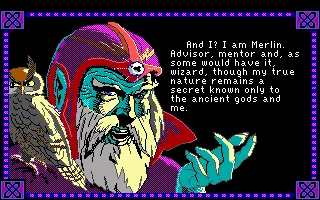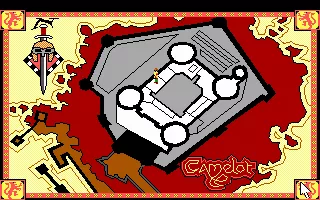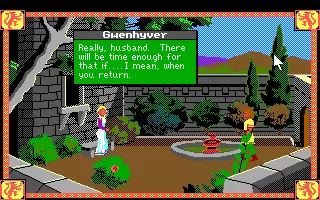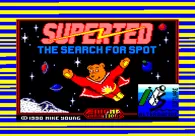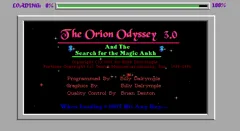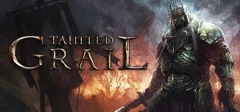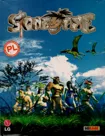Conquests of Camelot: The Search for the Grail
Description official description
It is the ninth century, and Camelot, the legendary castle ruled by King Arthur, has fallen under a curse. Famine and drought plague the kingdom because of the love triangle between the king, his wife Gwenhyver, and the knight Launcelot. It appears that only the mysterious Holy Grail can restore Camelot, and three knights - Launcelot, Gawaine, and Galahad - embark on a journey to find it, and soon disappear without a trace. King Arthur leaves his castle in search of the missing knights, hoping to locate the Grail as well. His quest takes him to real and mythical locations in England, and later to Jerusalem and other areas of the Holy Land.
Conquests of Camelot is an adventure game that requires the player to input text commands, mostly by combining verbs and objects (such as "look man", "take purse", etc). A few commands (such as "ask about") have keyboard shortcuts. Unlike most other adventures, the game does not focus extensively on inventory-based puzzles. Rather, it presents a diverse array of tasks depending on concrete situations. These involve exploration, solving riddles, gathering information, participating in arcade sequences such as jousting, and others. Rudimentary money management is present as well.
Many problems have different solutions, and it is possible to reach the final part of the game even without having completed some of the essential quests (e.g. failing to save the knights). However, Arthur is being judged by the game in three different categories: skill (referring to the action sequences), wisdom (evaluating the amount of cultural information gathered), and soul (determining the moral value of Arthur's action). Failure to achieve a high score in the last category leads to a bad ending.
The game is set in a concrete historical period, but adds an alternate reality to it, assuming that pagan deities really existed, but were overshadowed by Christian worship. However, there are only a few references to real religious practices of the time or any historical characters.
Groups +
Screenshots
Videos
Add Trailer or Gameplay Video +1 point
See any errors or missing info for this game?
You can submit a correction, contribute trivia, add to a game group, add a related site or alternate title.
Credits (DOS version)
35 People (34 developers, 1 thanks) · View all
| Executive Producer | |
| Game Designer | |
| Art Designer | |
| Producer | |
| Lead Programmer | |
| Composer | |
| Documentation | |
| Documentation Art | |
| Animators | |
| Background Artists | |
| Programmers | |
| Development System | |
| [ full credits ] | |
Reviews
Critics
Average score: 75% (based on 15 ratings)
Players
Average score: 3.7 out of 5 (based on 65 ratings with 7 reviews)
I'd take a Christy Marx game over a Roberta Williams game
The Good
It's more mature than Roberta Williams' King's Quest games, including the slightly adult comedy, which I think is often quite clever (to get the comedy you sometimes have to be clever or lucky enough to think of the correct line to type). I like the semi-historical, semi-mythological/religious content and that it's set in the "west"(England) and "east"(Israel), there doesn't appear to be much bias, though part of the ending arguably shows a Christian bias. I'd say that the problem solving and battles are challenging, but not excessively so(except for the Saracen) and to balance the difficulty, the game is quite short.
The game has a serious feel, but is balanced by Merlin's comedy and the history, mythology and religion being sometimes taken lightly. Christy Marx has arguably put a kind of feminism in the game, as King Arthur you often have to prove yourself to females, including the goddess Aphrodite, to progress in your quest for the holy grail. Whether it's really feminist or not, it makes the game stand out, especially in its time. I also like that there is a blurring of good and evil, friend and foe e.g in Guinevere, Lancelot, The Lady of the Lake, Aphrodite and her servants etc.
The Bad
The Saracen knight, who serves as the game's final boss, and the battle system you have to learn to beat him. I like the knight himself, he's presented as an honorable foe, but I can't say I enjoyed the challenge of learning the attack and defense, swordfighting system, defeating him was just too long and draining.
I think in the main, the game isn't preachy, though you're told that you must be "perfect" to acquire the grail ("perfect" is revealed to mean a strong fighter, clever and charitable/sacrificial) I think the game's story is presented as mythological, not too serious and there's some suggestion that the gods themselves aren't perfect. But there is one part that I think crosses the line, the part concerning the thief of Jerusalem and the way you or the grail itself deals with him. The thief appears comedic, he's dressed in only a loin cloth and turban, but his fate isn't very comedic even though the way the grail deals with him should be expected, the grail is supposed to expect perfection. But I think this part leaves a particularly bad taste right at the end, you appear to be serving a rather cruel and unforgiving god.
The Bottom Line
So it's fantasy like King's Quest, but more mature and adult and quite a bit better in my opinion. It has faults, but probably an above average Sierra adventure.
2 of 2 Moby users rated this review helpful.
Did you find this review helpful?
DOS · by Andrew Fisher (700) · 2018
Camelot is still splendorous even in EGA
The Good
I always loved Arthurian themes and this game was a great discovery, everything is very accurate and remains very faithful to the Arthurian myth.
The use of Olde-English in the dialogues is also a great point.
The fact of having to achieve certain actions and good deeds to obtain the Holy Grail was also very interesting to me.
The graphics were real good for being only 16, i liked a lot the maps of Europe and Britannia and some of the backgrounds.
The Bad
Maybe there were too much dead-ends like in a lot of Sierra adventures, the copy protection puzzles were a bit annoying (i hope we see an amateur-remake in VGA someday and this could be removed and changed to some similar puzzles)
The Bottom Line
If you are an adventure game enthusiast and enjoy reading King Arthur adventures this is definitely your game.
1 of 1 Moby users rated this review helpful.
Did you find this review helpful?
DOS · by Depth Lord (932) · 2004
Enjoyable, especially if you are interested in Greek/Roman mythology
The Good
There are quite a few games that focus on the Holy Grail, and Sierra's Conquests of Camelot: The Search for the Holy Grail is one of them.
The game starts off telling the player of the decline of Camelot as a result of the love triangle between King Arthur, Guinevere, and Lancelot. The other inhabitants of Camelot, Gawain, Lancelot and Galahad, had a vision of the Holy Grail and searched for it, never to return. King Arthur goes on a quest to find the three men and return with the Grail.
Arthur is assisted by Merlin to give him help and advice. You can ask about anything related to Greek or Roman mythology, and he will give you a lot of information regarding the subject. Furthermore, asking about objects in a particular location causes him to tell you about things that are related to Roman or Green mythology.
The adventure takes place around real locations in England, such as Glastonbury Tor and Southampton, as well as a few in the Middle East. Each of the game's locations look good, even in 16-color EGA, and this was at the time when VGA cards were not commonplace yet. If you have ScummVM and happen to have this game, you can load it up and select the undithered option. That way, the graphics don't have that checkerboard feel to them.
There are alternate solutions to puzzles, with some of these solutions leading to consequences. For example, much earlier in the game the player can decide whether to defeat the Black Knight in a joust match. If the player refuses to do so, then the Black Knight kills one of the knights you are meant to find. So, Conquests of Camelot is good on a replayability scale. Speaking of the jousting match, it is difficult to defeat your opponent, but it can be done. The animation of the Black Knight falling off his horse look excellent.
Since the game has a medieval setting, the music blends in well with both the setting and what you are doing. It sounds more realistic coming from a Roland MT-32 than an AdLib. The sound effects are well designed. I like the sound effects coming from the aforementioned sound device, especially when Arthur rides around on his horse.
The Bad
I don't like are those death messages that allow you to Restore, Restart, or Quit. Whereas death messages in other Sierra games are often informative and humorous, this one just says the same thing. To make up for it, there is an image of worms crawling out of your skull which looks nice.
I also didn't like the amount of copy protection in the game, which requires you to get out your Liber Ex Doctrina that came with the game to solve all of the game's puzzles.
The Bottom Line
So, for anyone who enjoys researching Greek or Roman mythology, or the evolution of Arthur and the Holy Grail, I would recommend this game. If you just like playing adventure games, especially from Sierra, then also give this game a try. Conquests was popular enough to warrant a sequel – from the same developer who brought you this game.
3 of 4 Moby users rated this review helpful.
Did you find this review helpful?
DOS · by Katakis | カタキス (43085) · 2014
Discussion
| Subject | By | Date |
|---|---|---|
| Conflicting info about Conquests of Camelot | Bullyt (524) | Feb 13, 2009 |
| areas with un-implemented puzzles? | Pseudo_Intellectual (67780) | May 22, 2007 |
Trivia
Glastonbury Tor
A portion of the game takes place in Glastonbury Tor. British legends indeed connect the Tor with Avalon, King Arthur and the Grail. Joseph of Arimathea allegedly traveled to Britain and left the Grail in Glastonbury where an Abbey was later built
In the game, there is a little tree, and if the player examines it, narration will tell them that this thorn tree was planted by Joseph of Arimathea. That tree known as 'Glastonbury Holy Thorn' actually existed in the Abbey, and died in 1991 according to Wikipedia
Also, the cover lid of the well seen in the very same screen, is curiously similar to the lid of the Chalice Well, an actual natural spring that exists in the area
Manual
In some portions, Merlin (the narrator) will refer to the Liber ex Doctrina, the copy protection manual of the game. If the player types 'Ask Merlin about Liber ex Doctrina', the cover of the manual will appear in a dialog window and Merlin suspiciously will warn the player that he must always have it in hand. The manual's name Liber ex Doctrina means 'Free/Book from doctrine' in Latin. Note that in Latin, liber means both free and book.
References
- The ship's name reads KRISTI in Greek letters, a reference to Christie Marx.
- Also, a sign in Jerusalem reads LEDGER in Greek, for her husband and the game's illustrator
- If you have a Roland MT-32 connected to your machine and selected as your MIDI device: Start the game, and watch the display on the Roland very carefully. You will see several messages, including: 'Conquest of Camelot' '(It's Only A Model)' And when you quit the game it reads: 'HAM&JAM&SPAMALOT' This is a reference to the movie Monty Python and the Holy Grail
Red herrings
There are a couple of red-herring places the player can find, without any significance to the game: * One is the snake corner in the desert, found only if the player strays from his or her path. The player can kill one snake with the sword, but won't be able to go further. Also, if players lose their way in the desert, they will see hallucinations about Lancelot and Guenevere * The player can also follow the tunnel of the pool of Siloam, however the screens will gradually darken and the player will die if he or she goes further. That tunnel is also the place where the player is 'transported' should he or she try to escape the riddles of Fatima. * Another such useless place is a dirty alley in Jerusalem, with a carcass of a dog and a pool of urine. The wall features Latin writing saying 'PRO BONUM TEMPUS APPELA CRISTI' translated as 'For a good time, call Christy', an obvious pun (and quite self-sarcastic) about the game creator herself
Runes
If the player examines the pedestal where the hag was standing on, in the stone circle, a dialog window will open with an icon of a runic inscription and its 'translation'. According to the narrator, the runes say about the five stone poets, encountered later in the game.
However if anyone tries to translate the runes with English letters (such guides can be found anywhere online), the 'actual' inscription doesn't say anything like that. The inscription actually contains the word 'Stormbringer' followed by the phrases 'death is all' and 'beware cursed is the wielder Thor'.
Other runes and words are too difficult to make out
Information also contributed by Itay Shahar
Analytics
Related Sites +
- Christy Marx's page for Conquests of Camelot: The Search for the Grail
The game's designer, Christy Marx has her own page for the game. - Conquests of Camelot - FAQs & Guides
Various fact files and walkthroughs on GameFaqs.com
Identifiers +
Contribute
Are you familiar with this game? Help document and preserve this entry in video game history! If your contribution is approved, you will earn points and be credited as a contributor.
Contributors to this Entry
Game added by andyhat.
Amiga added by POMAH. Windows added by Cavalary. Atari ST added by Terok Nor.
Additional contributors: Jeanne, Sciere, Bullyt, Boston Low, formercontrib, Patrick Bregger, Melony Fruitloop.
Game added May 4, 2000. Last modified November 22, 2024.


